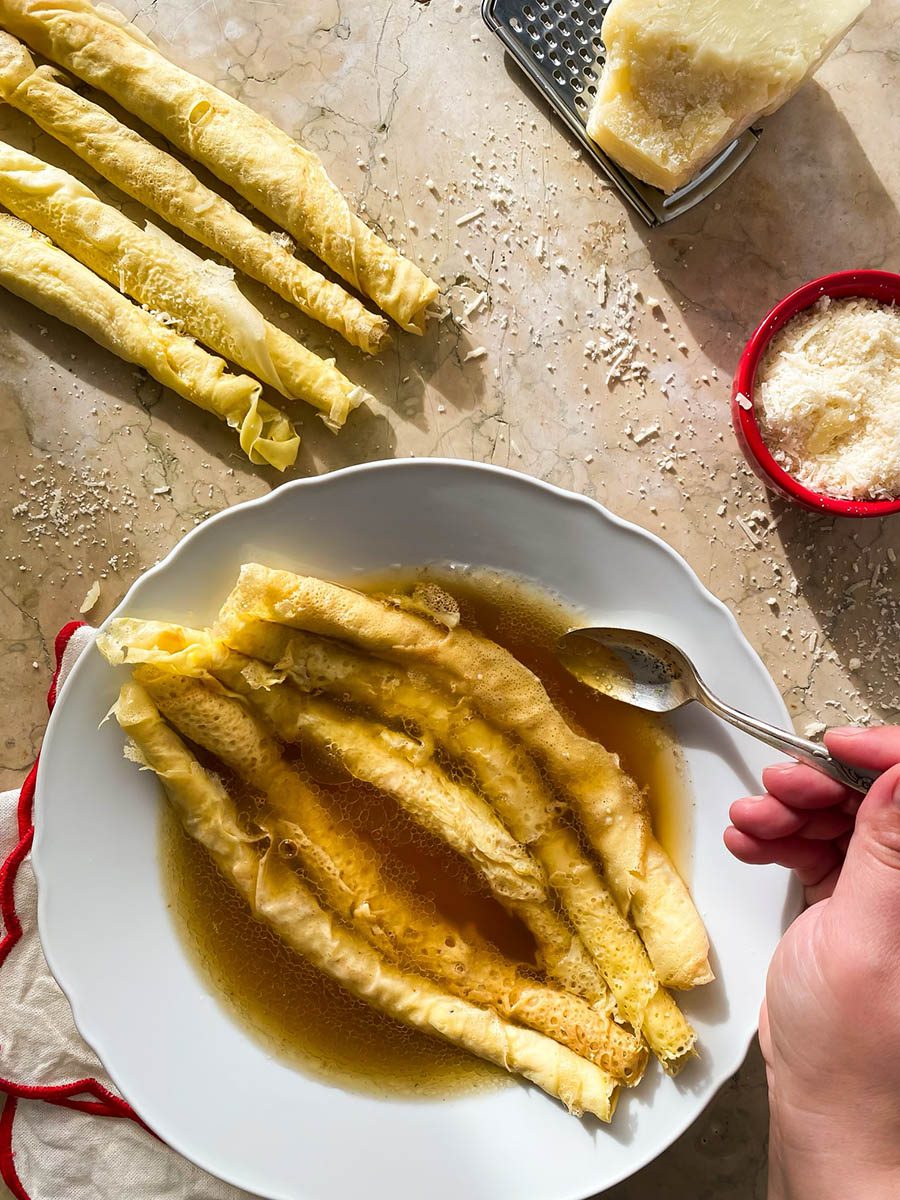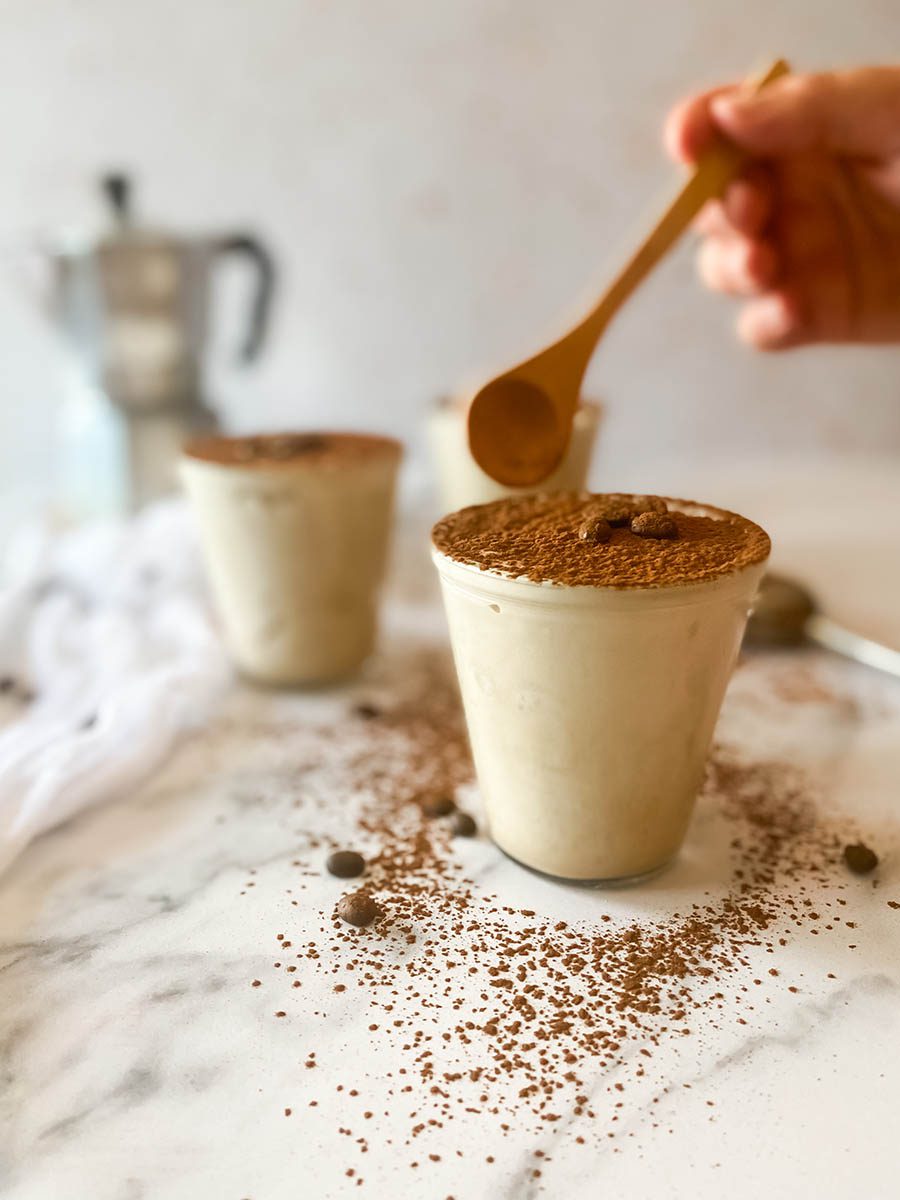Busiate Alla Trapanese Recipe: Delicious Quick lunch
I know there seems to be a theme to recipes lately, that theme being Sicilian recipes, and this one for busiate alla Trapanese is definitely no different. Mainly because we just couldn’t wait any longer as it’s too delicious to withhold.
And yes, it’s time for yet another recipe from one of the main islands in the Bel Paese. You know it better than me that the food here seems to be just great, recipe after recipe. And who are we to deprive you of the joy of such a delicious quick lunch – or dinner, for that matter! – that is this beautiful busiate alla trapanese? Exactly my point.
And because you have seen plenty of recipes from Sicily so far, I thought it would be worth having a tiny collection of links for you below:
- this pistachio lasagna from last week;
- these delicious involtini alla Siciliana;
- the pistachio granita you all deserve to try;
- something as delicious and easy as this gelo di limone;
- the pistachio cream you’ll be eating by the spoon;
- a recipe for limoncello and the panna cotta we made with it;
- the yummy recipe for pane cunzato;
- this delicious pesto alla siciliana is easy to make and oh-so-delicious;
- this biancomangiare recipe, a 10-minute dessert you will adore;
- and lastly, the latest impanata Siciliana.

This post for Busiate alla Trapanese contains affiliate links and we may earn a small commission when you click on the links at no additional cost to you. We would only recommend products we use and love ourselves; all opinions expressed here are our own. Please read our Privacy Policy here. Thank you!
Let’s get the busiate alla Trapanese ready, in no time
Busiate alla Trapanese, a traditional Sicilian dish, has a rich history deeply rooted in the culinary traditions of the Trapani province in western Sicily. The pasta, known as busiate, and its accompanying sauce, Pesto alla Trapanese, reflect the region’s unique cultural influences and local ingredients.
We won’t be making fresh pasta today, but you’re more than welcome to do so if you fancy. Our free ebook on fresh pasta can be downloaded by signing up for our newsletter below.
Historical Background of Busiate alla Trapanese
The name busiate is derived from the word busa, which refers to the thin reed or spindle traditionally used to shape the pasta. The shape of the busiate resembles a tightly wound spiral or corkscrew, achieved by twisting the dough around the reed. This technique is believed to date back to ancient times, possibly even to the Arab influence on Sicily during the Middle Ages. The Arab presence in Sicily significantly impacted local cuisine, introducing new ingredients and methods, including the cultivation of durum wheat used for pasta.
Pesto alla Trapanese, the sauce typically served with busiate, has its origins in the maritime culture of Trapani. The sauce is a Sicilian adaptation of the Genoese pesto, which sailors from Genoa brought to Trapani. However, the Sicilians adapted the recipe using local ingredients: tomatoes, almonds, garlic, basil, and Pecorino cheese. This combination created a vibrant, fresh sauce that reflects the agricultural bounty of Sicily.
What is the Cultural Significance of Busiate alla trapanese
Busiate alla Trapanese is more than just a dish: it’s a reflection of the diverse cultural exchanges that have occurred in Sicily over centuries. The blending of Arab and Italian culinary practices, combined with local ingredients, showcases the island’s ability to integrate and transform external influences into something distinctly Sicilian.
Today, Busiate alla Trapanese is a beloved dish both within Sicily and beyond. It represents the simplicity and richness of Sicilian cuisine, emphasizing fresh, high-quality ingredients. The pasta and sauce are often prepared by hand, maintaining the traditional methods passed down through generations. This dish is a staple in Sicilian households and a highlight in many Sicilian restaurants, celebrated for its historical roots and delightful flavours.



What ingredients do I need to make this busiate alla Trapanese dish?
We have made a little change to the most traditional Trapanese pesto and switched to our Sicilian pesto instead, which basically involves pine nuts instead of almonds. You can stick to the original Trapanese pesto recipe, but let’s see the rest of the ingredients together.
Let’s start with the pasta:
- Busiate pasta is a traditional Sicilian pasta, distinctively shaped like a twisted spiral or corkscrew. It is made from durum wheat semolina and water, which are kneaded together to form a dough. This dough is then rolled into long ropes and twisted around a thin rod or spindle to create its unique shape. The name busiate comes from the word busa, referring to the reed used to form the pasta’s spiral shape. Busiate is ideal for holding onto thick, chunky sauces like Pesto alla Trapanese due to its ridges and spiral form, which capture and cling to the sauce, ensuring each bite is flavorful and well-coated. This pasta is typically made fresh, but it can also be dried and stored for later use.
Now let’s talk about the ingredients for Pesto alla Trapanese, which is a vibrant, aromatic sauce originating from the Trapani province in Sicily. Unlike the more commonly known pesto alla Genovese, which uses pine nuts and basil as its base, Sicilian pesto incorporates local ingredients that reflect the region’s rich agricultural heritage. Here’s a closer look at the key ingredients in our Sicilian pesto:
- Vine Tomatoes:
- Fresh vine tomatoes are the cornerstone of Pesto alla Trapanese, providing a sweet and tangy flavour. They add juiciness and vibrant red colour to the pesto. The natural acidity of the tomatoes balances the richness of the nuts and cheese. You can also use cherry tomatoes if that’s what you have on hand;
- Parmesan:
- Parmesan cheese adds a sharp, nutty flavour and a creamy texture to the pesto. Its umami qualities enhance the overall taste, making the sauce richer and more complex;
- Pine Nuts:
- Pine nuts are used to add a buttery texture and a slightly sweet, nutty flavour. They also contribute to the creamy consistency of the pesto when blended;
- Extra Virgin Olive Oil:
- Extra virgin olive oil is essential for binding the ingredients together and adding a smooth, rich texture. It brings out the flavours of the other ingredients and adds a fruity, peppery note typical of high-quality Sicilian olive oil;
- Ricotta:
- Ricotta cheese is sometimes added to Pesto alla Trapanese for a creamy, mild flavour that complements the tanginess of the tomatoes and the nuttiness of the pine nuts. It makes the pesto creamier and adds a subtle sweetness;
- Garlic:
- Fresh garlic provides a pungent, spicy kick that elevates the flavour profile of the pesto. It adds depth and complexity, balancing the sweetness of the tomatoes and the creaminess of the cheeses;
- Basil:
- Fresh basil leaves bring a fresh, aromatic quality to the pesto. Their sweet, peppery flavour and fragrant aroma are essential components of the sauce, adding a bright, herbaceous note;
- Salt and Pepper:
- Salt enhances the flavours of all the ingredients, while freshly ground black pepper adds a touch of heat and earthiness, balancing the sweetness and acidity of the tomatoes and the creaminess of the cheeses;
- Pasta Cooking Water:
- The importance of pasta water in cooking, especially in dishes like Busiate alla Trapanese, cannot be overstated;
- Starch Content: Pasta water contains starch released from the pasta during cooking. This starch acts as a natural thickener, helping to bind sauces and create a cohesive dish;
- Texture and Emulsion: Adding pasta water to sauces like Pesto alla Trapanese helps to create a smoother, silkier texture. The starchy water helps emulsify the sauce, allowing the olive oil, cheese, and other ingredients to blend seamlessly with the pasta;
- Flavour: Pasta water is seasoned with salt, enhancing the overall flavour of the dish. Incorporating a bit of this water ensures the seasoning is well-distributed and that the pasta and sauce come together harmoniously;
- Consistency: The addition of pasta water allows for better control over the sauce’s consistency. You can adjust the thickness by adding small amounts of pasta water until the desired texture is achieved, ensuring the sauce clings perfectly to the pasta.
How do I make the pesto?
You will start off the Sicilian pesto by washing the tomatoes and basil. Pat them dry with a cloth, it doesn’t need to be perfect, just remove any excess water. Then add the tomatoes, parmesan, ricotta, pine nuts, olive oil, basil and garlic in a blender or food processor. Blend everything for a couple of minutes until you reach a creamy texture for your pesto rosso.
Afterwards, add salt and pepper to taste. Check if you need any more salt and pepper. Transfer the Sicilian tomato pesto to an airtight container and refrigerate if you are not using it straight away. Add some olive oil on top and your pesto sauce is ready to enjoy for you and your guests!
You can also freeze the pesto alla siciliana and keep it up for a month, it will be the perfect quick sauce for a weeknight dinner or when you don’t feel like cooking. As well as a dip for a quick appetizer when you have unexpected guests.
Can I make fresh busiate pasta myself?
You can indeed, and here’s the recipe for the pasta part of the busiate alla Trapanese.
Ingredients:
- 400 grams (about 3 1/4 cups) of semolina flour
- 200 ml (about 3/4 cup) of warm water
- A pinch of salt
Instructions:
- Prepare the Dough:
- On a clean work surface, create a mound with semolina flour and make a well in the centre;
- Add the warm water and a pinch of salt into the well;
- Gradually mix the flour and water together, starting from the centre and working outward, until a dough begins to form.
- Knead the Dough:
- Knead the dough for about 10-15 minutes until it becomes smooth and elastic. If the dough is too dry, add a bit more water. If it’s too sticky, add a bit more flour;
- Shape the dough into a ball, cover it with a clean cloth, and let it rest for at least 30 minutes.
- Shape the Busiate:
- After resting, divide the dough into smaller portions;
- Roll each portion into thin ropes, about 1/4 inch in diameter.
- Cut the ropes into pieces about 4-5 inches long;
- To form the characteristic spiral shape, take a piece of dough and wrap it around a thin rod (like a knitting needle or a skewer) at a 45-degree angle. Roll it gently to create the spiral;
- Slide the formed busiate off the rod and place them on a floured surface to dry slightly while you shape the remaining dough.
How do I make this busiate alla Trapanese dish?
To prepare Busiate alla Trapanese, the freshly cooked busiate pasta is tossed with the Sicilian pesto. The pasta’s spiral shape holds onto the chunky sauce beautifully, ensuring that each bite is full of flavour. The combination of fresh, tangy tomatoes, creamy ricotta, nutty Parmesan and pine nuts, aromatic basil, and robust garlic creates a harmonious and delicious dish that exemplifies the best of Sicilian cuisine.
This busiate alla Trapanese dish is a celebration of the region’s agricultural bounty and culinary traditions, bringing together simple, high-quality ingredients to create a meal that is both comforting and sophisticated. Whether enjoyed as a casual family dinner or a special occasion, Busiate alla Trapanese is a testament to the rich culinary heritage of Sicily.
Print
Busiate Alla Trapanese Recipe
- Total Time: 25 minutes
- Yield: Serves 4 people 1x
Description
Busiate alla Trapanese, a traditional Sicilian dish, has a rich history deeply rooted in the culinary traditions of the Trapani province in western Sicily.
Ingredients
- 400g busiate pasta
- 250g pesto alla siciliana
- fresh basil and parmesan cheese to garnish
Instructions
- Bring a large pot of salted water to a boil.
- Add the busiate and cook until al dente, usually about 8-10 minutes.
- Drain the pasta, reserving a cup of the pasta cooking water.
- Toss the pasta with the pesto in a large bowl, adding a bit of the reserved pasta water if needed to help the sauce coat the pasta evenly.
- Serve the busiate with a sprinkle of parmesan and a fresh leaf or two of basil.
- Prep Time: 10 mins
- Cook Time: 15 mins
- Category: Savoury
- Cuisine: Italian
Nutrition
- Serving Size:
- Calories: 642
- Sugar: 3.9 g
- Sodium: 651 mg
- Fat: 28.4 g
- Carbohydrates: 78.6 g
- Protein: 16.6 g
- Cholesterol: 0.9 mg
Keywords: busiate alla trapanese


Shop the busiate alla trapanese recipe post
Busiate alla Trapanese is a testament to the rich culinary history of Sicily, embodying centuries of cultural interaction and local ingenuity. The dish remains a cherished part of Sicilian cuisine, enjoyed for its unique taste and historical significance. Whether prepared traditionally or with modern variations, Busiate alla Trapanese continues to be a delicious reminder of Sicily’s vibrant culinary heritage.
For more pasta recipes like these busiate alla Trapanese, check these out:
- pasta alla cenere;
- ciriole pasta;
- pistachio lasagna;
- pasta alla crudaiola;
- rigatoni pomodoro;
- baked mostaccioli con ricotta;
- malloreddus;
- scarpariello pasta.
Pin the busiate alla trapanese recipe for later!









